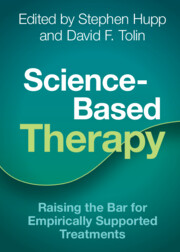Refine search
Actions for selected content:
103 results
From evidence to delivery: an Implementation-Science blueprint for behavioural policy
-
- Journal:
- Behavioural Public Policy , First View
- Published online by Cambridge University Press:
- 08 October 2025, pp. 1-12
-
- Article
-
- You have access
- Open access
- HTML
- Export citation
24 - Evidence-based practice
- from Part 5 - Drives Innovation
-
-
- Book:
- Leading and Managing Health Services
- Published online:
- 15 August 2025
- Print publication:
- 28 August 2025, pp 268-275
-
- Chapter
- Export citation
UK therapist views of barriers and facilitators to evidence-based CBT practice: a qualitative inquiry using the Theoretical Domains Framework
-
- Journal:
- The Cognitive Behaviour Therapist / Volume 18 / 2025
- Published online by Cambridge University Press:
- 18 August 2025, e39
-
- Article
- Export citation
Development and implementation of a value framework for rapid health technology assessment reports: enhancing evidence-informed decision making in resource-constrained settings
-
- Journal:
- International Journal of Technology Assessment in Health Care / Volume 41 / Issue 1 / 2025
- Published online by Cambridge University Press:
- 21 July 2025, e58
-
- Article
-
- You have access
- Open access
- HTML
- Export citation
Chapter 4 - Understanding the Evidence Base
- from Section 2 - Foundation Knowledge of Lifestyle Medicine
-
-
- Book:
- Essential Lifestyle Medicine
- Published online:
- 01 May 2025
- Print publication:
- 15 May 2025, pp 33-39
-
- Chapter
- Export citation
21 - Psychotherapy Relationships
-
-
- Book:
- Science-Based Therapy
- Published online:
- 10 January 2025
- Print publication:
- 16 January 2025, pp 381-398
-
- Chapter
- Export citation
1 - What Is Science-Based Therapy?
-
-
- Book:
- Science-Based Therapy
- Published online:
- 10 January 2025
- Print publication:
- 16 January 2025, pp 1-10
-
- Chapter
- Export citation
Postscript
-
-
- Book:
- Science-Based Therapy
- Published online:
- 10 January 2025
- Print publication:
- 16 January 2025, pp 399-405
-
- Chapter
- Export citation

Science-Based Therapy
- Raising the Bar for Empirically Supported Treatments
-
- Published online:
- 10 January 2025
- Print publication:
- 16 January 2025
Nutrition management programme for older adults in Ningxia nursing homes, China: evidence-based practice and the Delphi method
-
- Journal:
- Public Health Nutrition / Volume 27 / Issue 1 / 2024
- Published online by Cambridge University Press:
- 02 December 2024, e262
-
- Article
-
- You have access
- Open access
- HTML
- Export citation
11 - Evidence-Based Practice for LGBTQ+ People
- from Part III - Assessment and Treatment in LGBTQ+ Affirmative Counseling
-
-
- Book:
- LGBTQ+ Affirmative Counseling
- Published online:
- 31 October 2024
- Print publication:
- 04 July 2024, pp 197-215
-
- Chapter
- Export citation
13 - The Research–Practice Dialogue
-
- Book:
- A Practical Guide to Second Language Teaching and Learning
- Published online:
- 03 May 2024
- Print publication:
- 30 May 2024, pp 282-301
-
- Chapter
- Export citation
Towards designing for health outcomes: implications for designers in eHealth design
-
- Journal:
- Proceedings of the Design Society / Volume 4 / May 2024
- Published online by Cambridge University Press:
- 16 May 2024, pp. 1627-1636
-
- Article
-
- You have access
- Open access
- Export citation
Motor learning theory can benefit seafarers
-
- Journal:
- The Journal of Navigation / Volume 77 / Issue 3 / May 2024
- Published online by Cambridge University Press:
- 10 February 2025, pp. 415-426
- Print publication:
- May 2024
-
- Article
-
- You have access
- Open access
- HTML
- Export citation
Understanding mental health service needs and treatment characteristics for Latin American immigrants and refugees: A focus on CBT strategies for reducing acculturative stress
-
- Journal:
- The Cognitive Behaviour Therapist / Volume 17 / 2024
- Published online by Cambridge University Press:
- 11 April 2024, e12
-
- Article
-
- You have access
- Open access
- HTML
- Export citation
Preparing future doctors for evidence-based practice: a study on health technology assessment awareness and its predictors in Malaysia
-
- Journal:
- International Journal of Technology Assessment in Health Care / Volume 40 / Issue 1 / 2024
- Published online by Cambridge University Press:
- 28 February 2024, e18
-
- Article
-
- You have access
- Open access
- HTML
- Export citation
Reduction of anxiety symptoms among women within a collaborative care model and women’s health settings
-
- Journal:
- Primary Health Care Research & Development / Volume 24 / 2023
- Published online by Cambridge University Press:
- 04 December 2023, e69
-
- Article
-
- You have access
- Open access
- HTML
- Export citation
Implementing weight management during and after pregnancy to reduce diabetes and CVD risk in maternal and child populations
- Part of
-
- Journal:
- Proceedings of the Nutrition Society / Volume 84 / Issue 1 / February 2025
- Published online by Cambridge University Press:
- 01 December 2023, pp. 24-35
-
- Article
-
- You have access
- Open access
- HTML
- Export citation
Chapter 11 - Choice in Childbirth, Agency and Collective Action
-
-
- Book:
- Agency and Transformation
- Published online:
- 23 November 2023
- Print publication:
- 30 November 2023, pp 265-288
-
- Chapter
- Export citation
Industrial-organizational psychologists and volunteer work
-
- Journal:
- Industrial and Organizational Psychology / Volume 16 / Issue 4 / December 2023
- Published online by Cambridge University Press:
- 19 October 2023, pp. 421-432
-
- Article
- Export citation
